If you’re looking for help to identify black and white ducks, this will be the best article you read today.
In this post, you will find photos, identification info, calls, and all the fun facts you need.
Examples of black and white ducks include the tufted duck, ring-necked duck, spectacled eider, smew, greater scaup, hooded merganser, Barrow’s goldeneye, and many others.
Here are 21 of the most interesting ones.
Table of Contents
Black And White Ducks
Ring-necked Duck

- Scientific Name: Aythya collaris
- Lifespan: up to 20 years
- Wingspan: 24.6 in
- Color: Glossy black and grayish-white
Ring-necked ducks are small diving ducks found in North America, around freshwater ponds and lakes.
They resemble tufted ducks, their European relatives; to identify them, look for the species’ distinctive, peaked heads.
Male ring-necked ducks are bold black with white chests, grayish-white sides, and yellow eyes.
Females are grayish-brown with white patches near their beaks, and with white eyerings.
Both sexes also have white bands on their gray bills.
Ring-necked ducks can be vocal species and will make a series of short barks, grunts, and high “peeping” calls (in females).
These black and white ducks breed in wooded lakes and ponds of northern parts of Canada and the USA. They pair only during the reproductive season, build bowl-shaped nests on the water in dense vegetation, and lay 8-10 eggs.
After that, ring-necked ducks migrate to winter in southern North American ponds, lakes, rivers, and bays. They might gather in mixed flocks with other diving ducks.
Ring-necked ducks are omnivores that forage by dabbling or diving and have a diet consisting of insects, earthworms, snails, and plants.
They were named after the hard-to-spot collar on their black necks.
Tufted Duck

- Scientific Name: Aythya fuligula
- Lifespan: n/a
- Wingspan: 27.5 in
- Color: Black and white
Tufted ducks are the Old World counterparts of the North American ring-necked ducks.
These small diving ducks are commonly found around marshes, lakes, ponds, coastal lagoons, and shorelines of Europe and Asia; they might also winter along both coasts of the USA and Canada.
They were named after the tufts males have on their heads.
Male tufted ducks are all-black and have white flanks and blue-gray bills.
Females are mostly brown and have paler flanks.
People sometimes mistake tufted ducks for greater scaups and lesser scaups but those 2 species do not have tufts on their heads and have different calls.
Listen for the harsh “karr” calls female tufted ducks make and the whistling “wit-oo” courting calls of the males.
Source: Jamescandless, CC BY-SA 3.0, via Wikimedia Commons
These black and white ducks are omnivores: they find food mostly by diving and have a diet consisting of plants, mollusks, and insects.
During winter, they will form larger flocks.
Cotton Pigmy Goose
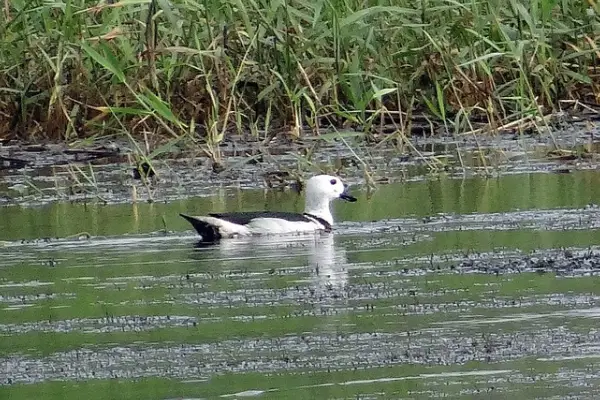
- Scientific Name: Nettapus coromandelianus
- Lifespan: n/a
- Wingspan: n/a
- Color: Green-black and white
Cotton pygmy geese are small perching ducks, and not geese as their name suggests.
They are also known as cotton teals and can be found in Asia, Africa, and Australia.
They are one of the smallest duck species in the world and can weigh as little as 5.6 oz and measure just 10 inches in length.
Male cotton pygmy geese have bright white heads and necks, dark crowns, a broad collar at the base of their necks, blackish backs, wing coverts, small black bills, and scapular feathers with green and purple gloss.
Females are plainer and have duller caps and brown eye-lines through their eyes.
Cotton pygmy geese are commonly found in pairs or larger groups, inhabiting waterbodies with lots of aquatic vegetation (freshwater wetlands, small ponds, and even farm dams).
Scientists once discovered around 5,400 of these black and white ducks in one flock at Chilka lake in India.
Cotton teals are omnivores and feed on plants, mollusks, small fish, and insect larvae.
Their breeding season coincides with the rain (June to August in India and January to March in Australia); they use tree holes to build their nests and females incubate their 6-12 ivory-colored eggs.
Listen for their low quacky calls that sound like “quacky-duck, quacky-duck.”
Source: Manoj Karingamadathil, CC BY-SA 4.0, via Wikimedia Commons
Read More: What ducks have black bills?
Knob-billed Duck
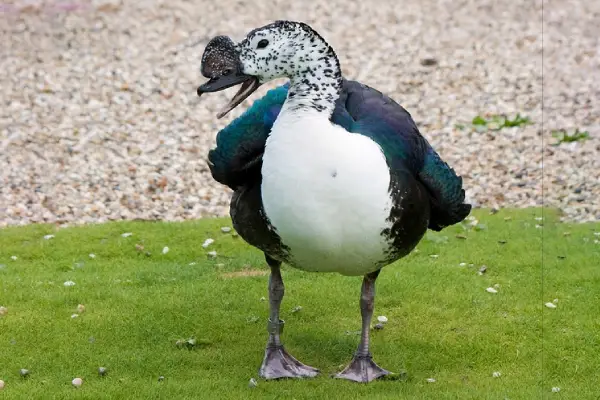
- Scientific Name: Sarkidiornis melanotos
- Lifespan: 20-30 years
- Wingspan: 46-57 in
- Color: Glossy blue-black and white
Knob-billed ducks are also known as African comb ducks and are one of the largest species of ducks in the world.
They can measure 22-30 inches in length and weigh up to 6.4 pounds.
Adult knob-billed ducks are unmistakable and have white heads with dark spots (freckles), white necks and underparts, and glossy black-blue upperparts.
Males are recognizable by their large black knobs on their beaks; females lack such conspicuous “accessorize”.
Both sexes have small crests of slightly curly feathers.
These ducks inhabit still freshwater rivers, lakes, and swamps of sub-Saharan Africa, India, and Southeast Asia.
Although mostly quiet, knob-billed ducks will hiss, wheeze, grunt, or croak, when annoyed or when displaying.
They nest in tall grasses or tree cavities around 25 feet above the ground and lay 7-15 yellow-white eggs.
Knob-billed ducks forage by grazing or dabbling and consume seeds, grasses, sedges, wheat, small fish, and invertebrates.
They are rather social birds and will form small flocks during the wet season, and large ones (up to 100 individuals) during the dry season.
Similar to other tree ducks, knob-billed ducks might resort to “dump nesting” where several females lay their eggs in one nest.
African Black Duck

- Scientific Name: Anas sparsa
- Lifespan: n/a
- Wingspan: n/a
- Color: Black and white
African black ducks are black ducks with white markings on their backs.
They also have dark beaks, purplish-blue speculum seen during flight, and orange-colored legs and feet.
African black ducks are found in eastern and southern parts of sub-Saharan Africa, in countries like South Africa, Uganda, South Sudan, Ethiopia, Nigeria, Cameroon, Gabon, and many others.
They inhabit well-wooded, fast-flowing rivers, ponds, and streams with rocks.
African black ducks are omnivores and feed on different aquatic vegetation, waterweeds, fruits, aquatic insects, larvae, crustaceans, and fish spawn. They forage by dabbling, mostly at dawn and dusk.
These rather shy ducks are also very territorial and can be usually seen in pairs or small flocks.
African black ducks use driftwood and matted grass to make their cup-shaped nests. They breed in different parts of the year, depending on the country, and females typically lay 4-8 eggs.
Long-tailed Duck

- Scientific Name: Clangula hyemalis
- Lifespan: 15 years
- Wingspan: 28 in
- Color: Black and white (in summer)
Long-tailed ducks, also known as oldsquaws, are medium-sized sea ducks with rounded heads, long tails (4-6 in), and small beaks.
They breed in the Arctic, in tundra and taiga regions; they winter along the northern coasts of the Pacific and the Atlantic Oceans.
These ducks have several plumages, depending on the season.
Male long-tailed ducks are mostly white and black during winter – they have white heads, white backs, and dark breasts and bodies.
In summer, they look the opposite – males become all-black with white cheek patches.
Females are brownish overall and have white faces and large dark cheek patches during winter; their heads become darker during summer.
Their scientific name “Clangula” comes from a Latin word meaning “to resound” or “noisy” while the “hyemalis” refers to the Latin word that means “of winter”.
Identify long-tailed ducks by their vocalizations: males will often make musical yodeling “ow-ow” calls.
Source: Tony Phillips, CC BY 3.0, via Wikimedia Commons
They feed on small fish and invertebrates and can go as deep as 200 feet below the surface to get them.
They are the only ducks that use wings to dive which allows them to reach such depths.
Spectacled Eider
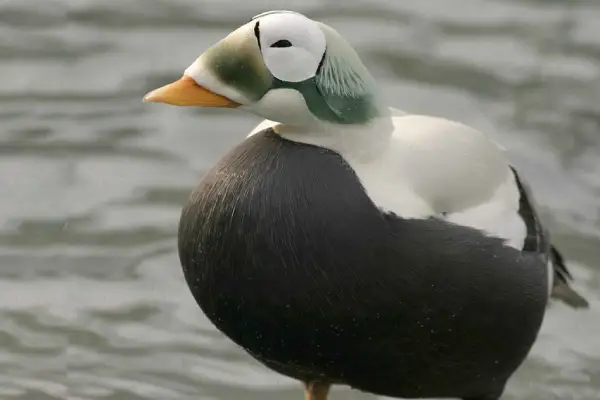
- Scientific Name: Somateria fischeri
- Lifespan: up to 15 years
- Wingspan: 36 in
- Color: Black, white, and green
Spectacled eiders are large sea ducks that measure around 21 inches in length and have a wingspan of 36 inches.
These unique-looking birds breed on the tundra in Alaska and far eastern Russia and winter in huge flocks in the Bering Sea.
They reach their breeding grounds in late May and June; females lay 3-9 olive-green eggs and take care of the eggs alone as males leave them.
Spectacled eiders are unmistakable with their black bodies, white backs, and brilliant white “goggles” outlined in black.
They also have carrot-orange beaks.
Females are mostly dark brown with pale goggles.
Part of their scientific name “fischeri” is after Johann Fischer von Waldheim, a German scientist.
Spectacled eiders mostly forage by dabbling and diving and can stay underwater longer than most other ducks.
They are omnivorous and have a diet consisting of mollusks, aquatic insects, crustaceans, and plants.
Identify male spectacled eiders by the soft “hoo-hoo” calls during courting and guttural croaks of the females.
Want to see more ducks with orange-colored bills? Check this article.
Steller’s Eider
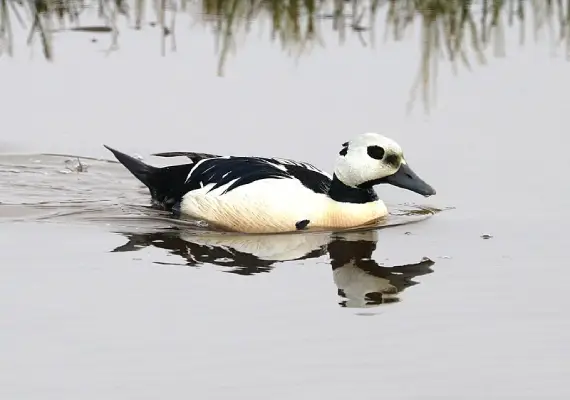
- Scientific Name: Polysticta stelleri
- Lifespan: 20-25 years
- Wingspan: 27 in
- Color: Black, white, and buff
Steller’s eiders are the smallest, rarest, and fastest of all the other eider species.
They breed along the coastlines of Alaska and eastern Russia and winter in coastal waters along the Aleutians, far eastern Russia, and northern Europe.
Male Steller’s eiders are hard to miss by their bold black and white plumage – they have white heads and shoulders, black caps, chins, throats, eye-rings, rumps, and buffy underpants.
Females have brownish plumage, white eye-rings, white edges on inner wing feathers, and iridescent bluish-purple speculums.
These ducks forage near the shore and get their food by diving, waddling, and dabbling – Steller’s eiders are omnivores and feed on small aquatic animals, insects, and seeds.
They are monogamous for a season and the pair will have a clutch of 5-10 brownish-orange eggs.
They are quieter than other eider species but will make soft guttural calls that resemble growls and barks, “qua-haa” sounds, and repetitive cackling sounds.
Interestingly, males court the females in silence.
Due to changes in the Arctic climate, predation, diseases, and lead poisoning, their numbers have decreased, and are listed as Vulnerable by the International Union for the Conservation of Nature (IUCN).
Common Eider
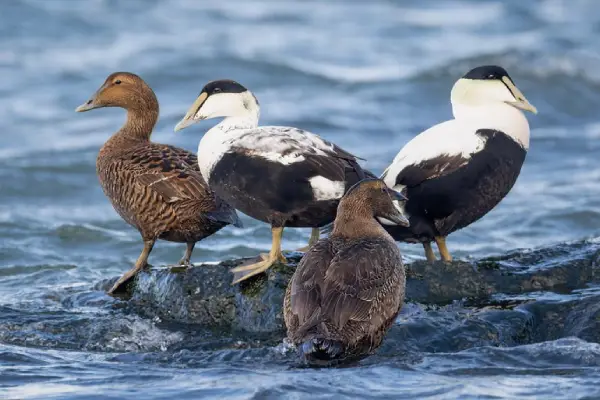
- Scientific Name: Somateria mollissima
- Lifespan: 20 years
- Wingspan: 31-43 in
- Color: Black and white
Common eiders are one of the largest sea ducks found in the northern hemisphere.
They measure 20-28 inches in length, weigh up to 6.7 pounds, and span 31-43 inches across the wings.
Common eiders, also known as St. Cuthbert’s ducks or Cuddy’s ducks, are stocky ducks that hold their sloping heads below body level when flying.
Males are mostly black and white – they have white heads, necks, chests, and backs, and black crowns, breasts, bellies, sides, rumps, and tails.
Females are russet-brown and gray.
Common eiders breed colonially and can make flocks ranging from 100 to over 15,000 individuals.
They breed in the Arctic, along the coast of northern parts of North America, south to Maine in the east, and south to the Alaska Peninsula in the west.
In the east, they winter from Greenland to the Gulf of St. Lawrence and south along the Atlantic Coast to Virginia; in the west, south to southern Alaska.
Common eiders are known for the insulating quality of their feathers; these ducks will line their nests with their own feathers to keep the eggs warm.
Quite a vocal species, common eiders will make pleasant cooing calls, harsh “kor-korr” alarm calls, and low “gog-gog” sounds.
Source: Aubrey John Williams , CC BY-SA 4.0, via Wikimedia Commons
They are known for “creching” where female eiders work and raise their ducklings together.
Common eiders are mostly found in marine water, near rocky seacoasts.
They are carnivores and feed on mollusks, spider crabs, sea urchins, fish eggs, and marine worms.
White-winged Duck
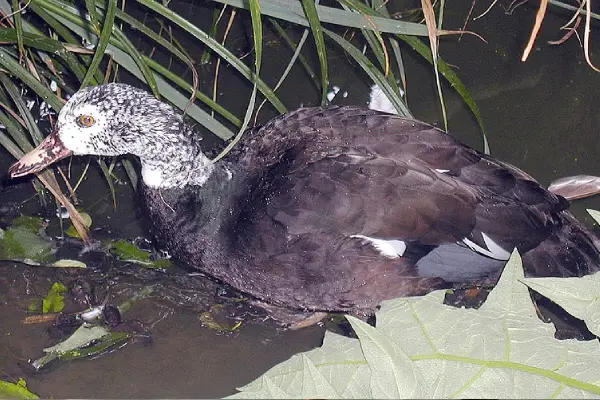
- Scientific Name: Asarcornis scutulata
- Lifespan: 10-15 years
- Wingspan: 46-60 in
- Color: Blackish and white
White-winged ducks are also known as white-winged wood ducks.
They are one of the largest duck species in the world and measure 26-32 inches in length, weigh up to 8.6 pounds, and span up to 5 feet across the wings.
Their stunning appearance makes them one of the pretties on our list of black and white ducks.
Male white-winged ducks have blackish plumage and white heads with black speckles.
Females are smaller than males are have mottled heads and upper necks.
White-winged ducks are rather shy species and feed at night. They consume seeds, grain, rice, aquatic plants, insects, snails, and small fish.
White-winged ducks are found in Asia, around dense tropical evergreen forests, rivers, and swamps. They inhabit countries like Laos, Thailand, Vietnam, Cambodia, Indonesia, India, Bangladesh, and Burma.
These long-necked ducks are cavity nesters that use tree holes high from the ground to build their nests and lay up to 16 eggs. White-winged ducks are monogamous and mate for life.
Due to hunting, habitat loss, and small population, the IUCN has listed them as Endangered with an estimated 1,000 individuals in existence today.
Radjah Shelduck

- Scientific Name: Radjah radjah
- Lifespan: 5-10 years
- Wingspan: 11 in
- Color: Black, white, and brown
Radjah shelducks are large ducks found in northern Australia and New Guinea.
The word “radjah” means “king” or “prince” in Hindi; these ducks are also called Burdekin ducks after the Burdekin River in Queensland, Australia.
Radjah shelducks have unique plumage that sets them apart from other ducks – they are black and white with white heads, chests, and underparts, black backs, wingtips, rumps, and tails, and a distinctive dark band across their chests.
Notice their pale eyes and pink beaks and feet.
Males will make hoarse whistling noises while the females will emit wheezy, low-pitched notes that resemble quacks.
They are strong swimmers but also great runners that can cross the muddy banks they are commonly found in with ease.
Radjah shelducks inhabit mangrove forests and sandy and muddy coasts and can be occasionally seen inland.
They forage by grazing or dabbling in shallow waters and mudflats and have an omnivorous diet consisting of insects, mollusks, small fish, algae, seeds, and sedges.
When the breeding season comes, these white-headed ducks become very aggressive and might even attack their partners.
Radjah shelducks are monogamous and breed for life; they nest in hollow trees and both parents incubate their clutch of 6-12 eggs.
Smew

- Scientific Name: Mergellus albellus
- Lifespan: 8-10 years
- Wingspan: 25 in
- Color: Stunning black and white
Smews are small water diving ducks found in Europe and Asia.
They inhabit lakes, rivers, and reservoirs, either alone or in smaller groups.
They are also one of the most elegant-looking black and white ducks.
Male smews have white plumage and black backs, masks, breast bars, and V-shaped nape patches.
Females are gray with big white throats and cheek patches and reddish-brown heads.
Both sexes have bushy crests.
These ducks have bills with hooked tips and serrated edges – this helps grab fish when diving.
They are omnivores and have a diet that also includes larvae, aquatic animals, plants, seeds, snails, and crabs.
Smews breed in northern forests of Europe and Asia and migrate to winter on the sheltered coasts or inland lakes of the Baltic Sea, the Black Sea, Germany, and Great Brittain.
They breed in May, nest in tree holes, and have a clutch of 7-11 cream-colored eggs.
Due to their stunning white and black plumage, smews are in demand among duck collectors and can cost over 600$.
Lesser Scaup
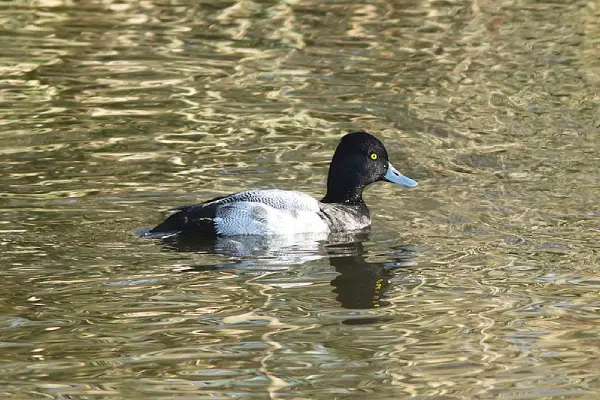
- Scientific Name: Aythya affinis
- Lifespan: up to 18 years
- Wingspan: 27-31 in
- Color: Black and white
Lesser scaups are small diving ducks found in North America.
People also call them “little bluebills” or “broadbills” because of their distinctive bluish bills with black tips.
Male lesser scaups are black and white with iridescent black heads (green or purple in the right light), white sides, black rumps, black and white barred backs, and yellow eyes.
Females are dark brown above, white below, brown on the sides, and have a white ring around their bills.
Lesser scaups often form large flocks and inhabit lakes, ponds, and rivers.
They breed in inland lakes and marsh ponds in the tundra in northern parts of North America; typically from May to June and lay 9-11 eggs.
They will then migrate south to winter on lakes, rivers, sheltered coastal lagoons, and bays in western and southern parts of the USA, Mexico, and Central America.
Lesser scaups are the most widespread species of diving ducks in North America, with an estimated population of slightly under 4 million.
They are omnivores and have a diet consisting of insects, mollusks, invertebrates, aquatic plants, and seeds.
Lesser scaups are related to greater scaups but there are several differences between the species.
Lesser scaups are slightly lighter and shorter; greater scaups have more rounded heads and larger and wider beaks.
Females will often make high-pitched “purr” calls.
During summer these black and white birds are one of many found in Colorado and Northern Texas.
Greater Scaup

- Scientific Name: Aythya marila
- Lifespan: up to 20 years
- Wingspan: 28-33 in
- Color: Black, white, and gray
Greater scaups are medium-sized diving ducks with round heads and yellow eyes.
In North America, they are also known as “bluebills” due to their conspicuous dull blue bills with black tips.
Male greater scaups have black breasts, black heads with a green gloss, white stripes on wings, and white bellies and sides.
Females are brown overall with white wing markings similar to those that males have.
Identify male greater scaups by their soft nasal courting whistles and females by their raspy “arr-arr” alarm calls.
In North America, they breed in shallow lakes and ponds of Northern Canada and Alaska and winter along the coasts of North America, shores of the Great Lakes, and in the Gulf of Mexico.
Greater scaups are monogamous and females will lay 6-9 olive-brown eggs.
During winter, they will form large groups consisting of hundreds and thousands of birds.
Greater scaups are omnivores and feed on insects, mollusks, crustaceans, plants, and seeds.
They are great at diving and can go up to 23 feet below the surface.
Hooded Merganser

- Scientific Name: Lophodytes cucullatus
- Lifespan: 11-12 years in the wild
- Wingspan: 23.6-26 in
- Color: Black, brown, and white
Hooded mergansers are small diving ducks with a striking appearance.
They are native to North America and both sexes have crests that they can raise or lower.
Male hooded mergansers have black upperparts, white breasts, large black heads with prominent white patches, and chestnut flanks.
Females are gray and brown and have puffy crests.
Hooded mergansers are common around inland lakes and ponds from spring to fall and then migrate to the east and west coasts of the USA to winter; they are usually in pairs or small flocks, but might occasionally mix with other ducks.
Identify hooded mergansers by their distinctive, rolling, frog-like “crrroo” calls.
Source: Jonathon Jongsma, CC BY-SA 3.0, via Wikimedia Commons
They are omnivores and feed on small fish, crawfish, aquatic insects, and some vegetation.
They hunt using their sight when underwater and can stay there for up to 2 minutes while chasing the prey!
They have a third eyelid called a “nictitating membrane” that is transparent and allows them to see when submerged with no injury to the eyes; camels also have such eyelids.
Hooded mergansers are monogamous for a season and will stay together until the female builds the nest and lays the eggs.
Males then leave the females to incubate their 7-15 whitish eggs and rear the young alone.
Common Merganser

- Scientific Name: Mergus merganser
- Lifespan: up to 13 years
- Wingspan: 34-37 in
- Color: Black and white
Common mergansers are the largest of the three merganser species found in North America.
They are also known as goosanders and measure 23-28.3 inches in length, span 3 feet 2 inches across the wings, and weigh up to 4.6 pounds.
Males have white bodies, black backs, dark heads, dark eyes, and thin red beaks.
Females are gray with reddish-brown heads, shaggy crests on the backs of their heads, and red beaks.
Common mergansers are found in Europe, Asia, and North America.
They breed in northern parts of the US and Canada and can be commonly found around lakes and rivers.
Look for ducks sitting on rocks in midstream, disappearing around the bends, or flying along the river.
You might spot gulls waiting for these ducks to come to the surface with fish and then try to steal their prey.
Common mergansers are carnivores that mainly feed on fish, mollusks, crustaceans, worms, insect larvae, and amphibians.
They are cavity nesters, they build their nests in tree cavities, and females lay 6-17 white-yellowish eggs.
These black and white ducks are, similarly to common eiders, known to form creches and work together in raising ducklings.
Scientists once recorded a female with 76 ducklings at the time!
You can also attract common mergansers by adding nest boxes, just make sure that the entrance is 6 inches in diameter.
Common Goldeneye
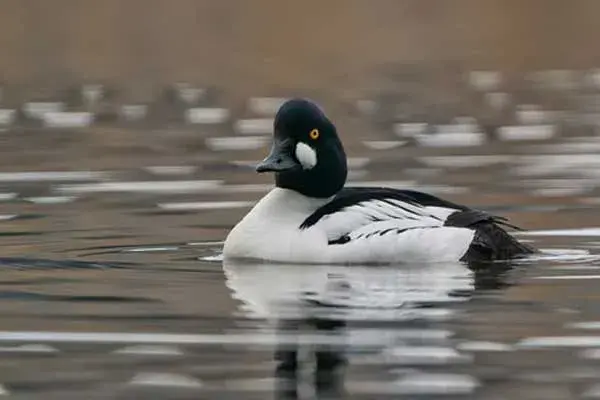
- Scientific Name: Bucephala clangula
- Lifespan: up to 20 years
- Wingspan: 30.3-32.7 in
- Color: Black and white
Common goldeneyes are medium-sized ducks found in North America, Europe, and Asia.
They can be recognized by their large heads and fairly small and narrow beaks.
Common goldeneyes have mostly black and white plumage – their heads are dark black-green, they have round white spots near the beaks, and the rest of the body is crisp black-and-white.
These birds got their name from their golden-yellow eyes.
In case you decide to look for them, watch for flocks on fairly large bodies of water, their distinctively shaped heads, and the bright yellow eyes that can be seen from afar.
Common goldeneyes are aggressive and territorial ducks that have elaborate courtship rituals.
Males often bend their heads backward to touch their rumps, thrust forward, and kick up water with their feet to seduce a female.
Common goldeneyes are water-diving birds that forage underwater and have a diet consisting of crustaceans, aquatic insects, and mollusks.
In North America, they breed in lakes and rivers of boreal forests in Canada and the northern USA and migrate south to winter in protected coastal waters or open inland waters.
Barrow’s Goldeneye

- Scientific Name: Bucephala islandica
- Lifespan: up to 18 years
- Wingspan: 28-30 in
- Color: Black and white
Barrow’s goldeneyes are medium-sized sea ducks that were named after Sir John Barrow, a famous 18th-century explorer.
Adult males are mostly black and white, with bright yellow eyes, and white spots near the bills.
Despite being rather quiet, Barrow’s goldeneyes will make various sounds during their breeding season: low-volume squeaks, grunts, and croaks.
They breed in wooded lakes and ponds of northwestern parts of North America and some parts of eastern Canada and in Iceland.
These black and white ducks are migratory and will move to protected coastal waters or open inland waters of the northwestern USA during winter.
Barrow’s goldeneyes forage by diving and have a diet consisting of aquatic insects, crustaceans, and pond vegetation.
They are often found in mixed flocks with common goldeneye that they resemble – Barrow’s goldeneyes have more black on their backs, the purple sheen on their heads (not green), crescent-shaped (not circular) white patches on their faces, and shorter bills.
Barrow’s goldeneyes have a rather long lifespan – the oldest individual ever recorded had 18 years!
White-winged Scoter

- Scientific Name: Melanitta deglandi
- Lifespan: up to 18 years
- Wingspan: 31.5 in
- Color: Black and white
White-winged scoters are large sea ducks and the largest scoter species in the world.
They can measure 19-24 inches in length, weigh almost 4.7 pounds, and span around 2.6 feet across their wings!
Male white-winged scoters are silken black overall with large white patches on the wings that are visible mostly during flight and white spots around the eyes.
They also have a distinctive knob at the base of their orange beaks; their necks are thick and their heads have sloping foreheads.
Females are dark brownish-black and have two whitish patches on the sides of their heads, and black-gray beaks that have a less prominent black knob at their bases.
White-winged scoters are common around freshwater lakes and wetlands in the northwestern parts of North America.
They will spend winter on the Great Lakes, the coasts of the northern United States, and the southern coasts of Canada.
They are omnivores that feed mostly on mollusks, crustaceans, fish, insects, and some plants.
Because of their large size, white-winged scoters can dive over 65 feet to find larger prey.
These enormous waterbirds are also monogamous and stay together for life.
Further Reading: More examples of the world’s largest black birds
Surf Scoter
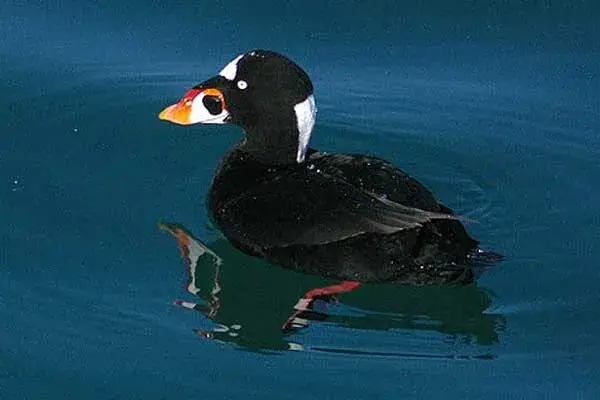
- Scientific Name: Melanitta perspicillata
- Lifespan: 9-10 years
- Wingspan: 30-36 in
- Color: Jet black and white
Surf scoters are large sea ducks native to North America.
They are “molt migrants” – after nesting, adults will go to a specific area to molt their flight feathers.
Male surf scoters are jet black with white patches on the foreheads, napes, and bases of their beaks.
Their conspicuous beaks are a mixture of orange, white, and black.
Females are slightly smaller and more brown.
Surf scoters breed in Canada and Alaska and migrate to the Atlantic and Pacific coasts of North America for winter.
They breed in boreal forests near freshwater lakes and winter in marine habitats near the shore.
These birds are mostly quiet but will make a couple of sounds: gurgling calls, explosive “puk-puk,” and “guk” alarm calls.
To catch the prey, they will dive and go up to 30 feet deep.
Surf scoters are carnivores and mostly feed on mollusks, crustaceans, aquatic insects, small fish, marine worms, etc.
Muscovy Duck
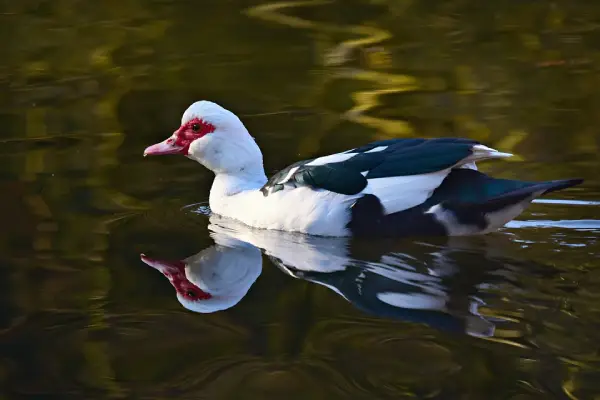
- Scientific Name: Cairina moschata
- Lifespan: 8-12 years
- Wingspan: 54-60 in
- Color: Black and white
Muscovy ducks are large ducks native to Mexico, Central, and South America – they originated in Brazil.
Males are twice the females’ size and measure around 30 inches in length and can weigh up to 15 pounds which makes them the heaviest ducks in North America.
Domesticated muscovy ducks are mostly black and white; they have white heads with crests on their napes, multicolored beaks (black, pink, or yellow), and pink-red wattles around the beaks.
Identify males by their low breathy calls and females by their quiet trilling “coo“.
Muscovy ducks are omnivores and feed on small fish, snails, seeds, and larvae.
They inhabit forest swamps, lakes, and streams and nest in tree holes where they lay 8-16 eggs.
In the USA, wild muscovy ducks were introduced and have a very limited range; the largest population is in the Rio Grande Valley in Texas.
Despite sharing the name with a region surrounding Moscow in Russia, it is thought that they were named after the 16th century “Muscovy Company” which transported these ducks to England and France.
Summary
This concludes our list of black and white ducks.
Examples of black-and-white-colored ducks include several types of diving ducks, dabbling ducks, stiff-tailed ducks, sea ducks, etc.
Hopefully next time you see these birds, you will recognize any of them with ease!
And if you enjoyed our article, here are our other popular reads on birds: List of ducks that have red eyes